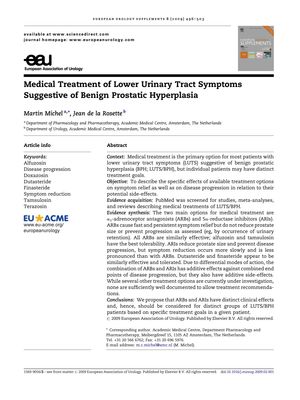Medical Treatment of Lower Urinary Tract Symptoms Suggestive of Benign Prostatic Hyperplasia
February 2009
in “
European urology. Supplement
”

TLDR Treatment for benign prostatic hyperplasia involves drugs that either quickly relieve symptoms or reduce prostate size, with a combination offering more benefits but more side effects.
Medical treatment for lower urinary tract symptoms (LUTS) suggestive of benign prostatic hyperplasia (BPH) primarily involved α1-adrenoceptor antagonists (ARBs) and 5α-reductase inhibitors (ARIs). ARBs provided fast and persistent symptom relief but did not reduce prostate size or prevent disease progression, with alfuzosin and tamsulosin being the best tolerated. ARIs reduced prostate size and prevented disease progression, though symptom relief was slower and less pronounced compared to ARBs, with dutasteride and finasteride being similarly effective. Combining ARBs and ARIs had additive effects on disease progression but also increased side-effects. The choice between ARBs and ARIs should be based on individual patient treatment goals.

